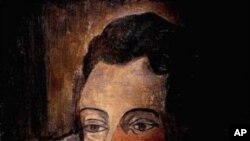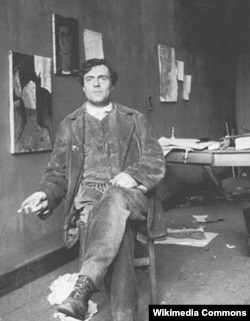Goran Hadzic has been called many things in his day.
Some in the Croatian city of Vukovar, where he is accused of playing a leading role in the 1991 massacre of more than 250 non-Serbs, refer to him as “the master of life and death.” Until his capture yesterday, the UN-backed war crimes tribunal for the former Yugoslavia called him their last remaining fugitive. But never in his life has Hadzic been called an art collector.
He doesn’t merit that distinction today either. But in revealing how police finally nabbed the former leader of ethnic Serbs in Croatia, officials traced an unexpected link between Hadzic and the more savory world of fine art.
On the morning of July 20, authorities swooped in on Hadzic in a forest outside the Serbian village of Krusedol, where he was allegedly to meet a money courier.
Later in the day, Serbia's chief prosecutor for war crimes, Vladimir Vukcevic, told reporters in Belgrade, "The strategic breakthrough in detaining Goran Hadzic came after an attempt to sell a Modigliani painting. We came to the conclusion that [Hadzic] had run out of money and we started to follow that contact and to track communications related to that painting."
The painting in question is a 1918 work entitled, “Portrait of a Man.” It shows just that -- the face of a young man with full lips and dark brown hair, viewed slightly from the side, and partially covered in shadow. The head and nose are elongated -- the characteristic touch of Italian modern art icon Amedeo Modigliani.
Serbian deputy war crimes prosecutor Bruno Vekaric has said he believes the painting is worth some 22 million euros ($31 million).
Fugitive Painting?
The mystery behind the Modigliani work -- and how it came to feature in the arrest of one of the world’s most wanted men -- is now the primary focus of a team of Serbian investigators and a number of international art experts.
According to a Reuters report from September 2007, “Portrait of a Man” had been unknown to the art world before it surfaced in the Balkan country. The report said the painting was owned by an unnamed Serbian collector and quotes Christian Parisot, the president of the Modigliani Institute, as saying that after a 17-year verification process, the painting had been deemed authentic.
The work appears to have next turned up in late 2010, when Serbian authorities raided the home of one Zoran Mandic, a close friend of Hadzic. Authorities said Mandic was trying to sell the work on Hadzic’s behalf, intending to funnel him the money from the sale.
Prosecutors say state security agents monitored Hadzic's suspected aides, including friends and family, for months thereafter, finally leading to his arrest.
But is the painting that authorities seized the same one that surfaced three years before? If so, had it been stolen? Or could it be a fake?
With Hadzic a fugitive no more, Serbian authorities now apparently have the time to search for answers.
The Riddle Continues
To do so, they are working with the London-based Art Loss Register, which maintains an immense private database of stolen and missing art work.
Executive Director Christopher Marinello told RFE/RL that it is the world’s largest such list, containing no less than 89 Modigliani works -- a number of which are called “Portrait of a Man.”
He says, however, after receiving a photo of the painting from Belgrade, that it is not listed in the database.
"We can now confirm that the work being held by Serbian authorities is not listed on our database as stolen, missing, or looted," said Marinello. "That doesn't mean there's not going to be a claim against the work, whether it's for money laundering, or whether there'll be any charges in connection with the painting."
All possibilities, in effect, remain open: The portrait could have been stolen but not reported to the Art Loss Register, it could have been in the possession of its undetermined, but rightful owner all along, or it could be a fake.
Petar Petrovic, a curator with the Serbian National Museum, has said that help from international art experts will be needed to determine the authenticity of the portrait.
Hadzic’s lawyer, Toma Fila, told reporters that whatever the real story is, his client has no direct connection to a work by Modigliani.
"There is no Modigliani: [Hadzic] neither tried to sell nor sold one," he said.
Marinello notes that there is a strong precedent for illegal art dealings in Serbia, whether or not that’s the case with the Modigliani portrait.
"Ever since the war and the chaos that followed, Serbia and the surrounding countries were certainly a hotbed of stolen art, [art traded by criminal gangs], and fake art, and it continues to this day. It has somewhat dissipated, but we have a great number of cases that involve someone in that area trying to sell a work that is either stolen or a known fake," he said.
Even after Goran Hadzic’s modern art mystery is solved, there may be more in store.
Along with “Portrait of a Man,” some 50 other art works were seized at the house of Hadzic’s friend.
Marinello says he is awaiting descriptions of those works to see if any appear in his database.
-- Richard Solash
Some in the Croatian city of Vukovar, where he is accused of playing a leading role in the 1991 massacre of more than 250 non-Serbs, refer to him as “the master of life and death.” Until his capture yesterday, the UN-backed war crimes tribunal for the former Yugoslavia called him their last remaining fugitive. But never in his life has Hadzic been called an art collector.
He doesn’t merit that distinction today either. But in revealing how police finally nabbed the former leader of ethnic Serbs in Croatia, officials traced an unexpected link between Hadzic and the more savory world of fine art.
On the morning of July 20, authorities swooped in on Hadzic in a forest outside the Serbian village of Krusedol, where he was allegedly to meet a money courier.
Later in the day, Serbia's chief prosecutor for war crimes, Vladimir Vukcevic, told reporters in Belgrade, "The strategic breakthrough in detaining Goran Hadzic came after an attempt to sell a Modigliani painting. We came to the conclusion that [Hadzic] had run out of money and we started to follow that contact and to track communications related to that painting."
The painting in question is a 1918 work entitled, “Portrait of a Man.” It shows just that -- the face of a young man with full lips and dark brown hair, viewed slightly from the side, and partially covered in shadow. The head and nose are elongated -- the characteristic touch of Italian modern art icon Amedeo Modigliani.
Serbian deputy war crimes prosecutor Bruno Vekaric has said he believes the painting is worth some 22 million euros ($31 million).
Fugitive Painting?
The mystery behind the Modigliani work -- and how it came to feature in the arrest of one of the world’s most wanted men -- is now the primary focus of a team of Serbian investigators and a number of international art experts.
According to a Reuters report from September 2007, “Portrait of a Man” had been unknown to the art world before it surfaced in the Balkan country. The report said the painting was owned by an unnamed Serbian collector and quotes Christian Parisot, the president of the Modigliani Institute, as saying that after a 17-year verification process, the painting had been deemed authentic.
The work appears to have next turned up in late 2010, when Serbian authorities raided the home of one Zoran Mandic, a close friend of Hadzic. Authorities said Mandic was trying to sell the work on Hadzic’s behalf, intending to funnel him the money from the sale.
Prosecutors say state security agents monitored Hadzic's suspected aides, including friends and family, for months thereafter, finally leading to his arrest.
But is the painting that authorities seized the same one that surfaced three years before? If so, had it been stolen? Or could it be a fake?
With Hadzic a fugitive no more, Serbian authorities now apparently have the time to search for answers.
The Riddle Continues
To do so, they are working with the London-based Art Loss Register, which maintains an immense private database of stolen and missing art work.
Executive Director Christopher Marinello told RFE/RL that it is the world’s largest such list, containing no less than 89 Modigliani works -- a number of which are called “Portrait of a Man.”
He says, however, after receiving a photo of the painting from Belgrade, that it is not listed in the database.
"We can now confirm that the work being held by Serbian authorities is not listed on our database as stolen, missing, or looted," said Marinello. "That doesn't mean there's not going to be a claim against the work, whether it's for money laundering, or whether there'll be any charges in connection with the painting."
All possibilities, in effect, remain open: The portrait could have been stolen but not reported to the Art Loss Register, it could have been in the possession of its undetermined, but rightful owner all along, or it could be a fake.
Petar Petrovic, a curator with the Serbian National Museum, has said that help from international art experts will be needed to determine the authenticity of the portrait.
Hadzic’s lawyer, Toma Fila, told reporters that whatever the real story is, his client has no direct connection to a work by Modigliani.
"There is no Modigliani: [Hadzic] neither tried to sell nor sold one," he said.
Marinello notes that there is a strong precedent for illegal art dealings in Serbia, whether or not that’s the case with the Modigliani portrait.
"Ever since the war and the chaos that followed, Serbia and the surrounding countries were certainly a hotbed of stolen art, [art traded by criminal gangs], and fake art, and it continues to this day. It has somewhat dissipated, but we have a great number of cases that involve someone in that area trying to sell a work that is either stolen or a known fake," he said.
Even after Goran Hadzic’s modern art mystery is solved, there may be more in store.
Along with “Portrait of a Man,” some 50 other art works were seized at the house of Hadzic’s friend.
Marinello says he is awaiting descriptions of those works to see if any appear in his database.
-- Richard Solash





